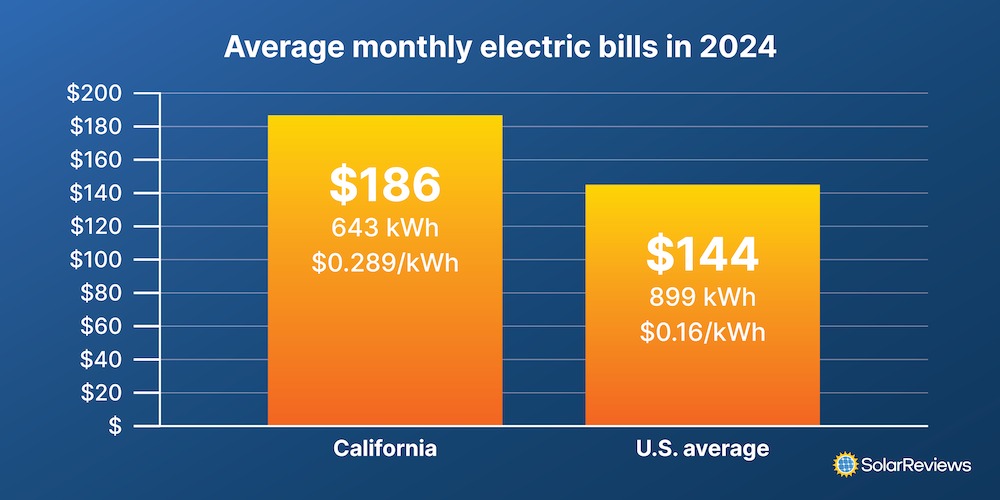Updated 1 year ago
Why California electricity bills are so high and what you can do about it
Written by
Ben Zientara

Find out how much solar panels can save on your electricity bills
In 2024, the average electricity bill in California is $186, which is over 29% higher than the average U.S. residential bill of $144.
California electricity bills have never been higher, mostly due to huge increases in electricity rates approved by the California Public Utilities Commission (CPUC). And customers of the big three investor-owned utility companies—Pacific Gas & Electric (PG&E), Southern California Edison (SCE), and San Diego Gas & Electric (SDG&E)—often pay much more than the California average price per kilowatt-hour (kWh).
Your bill varies based on your electric utility, the kind of home you live in, and the amount of energy you use. For example, PG&E now charges more for electricity than SCE or SDG&E. Also, people living in single-family homes use significantly more electricity than people living in apartment buildings, and people with all-electric appliances use more than those with gas appliances.
We’ll cover all these differences below and discuss how you can save money by conserving energy, switching to a Time of Use rate plan, and of course, getting solar panels for your home. If you’ve been pulling your hair out because of California’s high electricity costs, you’ve come to the right place.
Key takeaways
-
The average electricity bill in California is $186, based on a monthly usage of 643 kilowatt-hours and an average residential rate of 28.9 cents per kilowatt-hour.
-
The average electricity rate in California rose 9.5% in 2023 compared to 2022, and rates from specific utility companies like PG&E increased by much more than that.
-
The average California electricity bill differs based on your utility company, the kind of home you live in, and your consumption habits.
-
Californians who live in single-family homes have average bills of between $152 and $415 per month, depending on their utility company.
-
There are several ways to reduce your California electricity bills, including low-income assistance programs, Time of Use rates, and adding solar panels to your home.
-
Californians who add solar panels can save thousands of dollars per year, paying back the initial cost of their investment in just 8 to 10 years and enjoying decades of essentially free solar energy.
Average California electricity bills by utility and housing type

Each California utility charges different rates based on their unique mix of energy sources and the total cost to serve their customers. That means people in some places pay much more per kWh than others. SDG&E customers pay higher rates than customers of SCE, even though the utilities serve areas that are neighbors in some places.
There is also a huge difference in how much energy people use depending on the kind of home they live in.
Average electricity bills for different home styles
Electricity bills vary greatly based on your household's electricity consumption habits. When it comes to consumption, the size of your living space, and amount of occupants living in your household can impact the numbers on your bill each month.
The table below gives the what you can expect as an average electricity bill in California based on different types of homes:
Home type | Est. monthly consumption | Avg. monthly electric bill |
|---|---|---|
One-bedroom apartment | 400 kWh | $120 |
Two-bedroom apartment | 550 kWh | $165 |
Small house* | 730 kWh | $219 |
State average | 491 kWh | $147 |
Large house** | 1,600 kWh | $480 |
*Based on a 1,300 sq. ft. home
**Based on a 3,000 sq. ft. home
Changes in the cost of electricity over time
The average rate of increase in electricity prices in the United States over the past 25 years has been around 2% per year. Unfortunately, most California residents have experienced much quicker growth in the prices they pay for power. In just the past ten years, the average growth rate across all California utilities was more than 7.7% per year.
Here’s a table showing the average growth rates over the past ten years for customers of the five big California utilities we’re covering:
Utility | 2014 avg. rate/kWh | 2024 avg. rate/kWh | Annual % increase |
|---|---|---|---|
LADWP | $0.150 | $0.230 | 4.37% |
PG&E | $0.207 | $0.462 | 9.33% |
SCE | $0.195 | $0.367 | 7.28% |
SDG&E | $0.206 | $0.424 | 8.35% |
SMUD | $0.131 | $0.146 | 1.21% |
The reasons for these high rates of increase are numerous. Two of the most important are major upticks in the cost of natural gas used by power plants and rising costs associated with the upkeep of the electric grid. The cost to run the grid has skyrocketed as utilities strengthen their infrastructure to prevent or repair damage from wind storms and wildfires. Sadly, some California utilities have been allowed to pass the costs of those wildfires onto ratepayers.
What will happen to the cost of electricity in the future?
As we mentioned above, electricity costs in the United States have tended to increase around 2% per year over the long term, and California’s electricity costs have increased by much more than that in recent years. Does that mean California utilities will slow their requests for rate increases, and things will even out? Not likely.
In their current rate cases, PG&E and SDG&E both propose increases in the double digits over the coming few years. Estimates show that rates may increase between 32% and 50% for some California residents between 2022 and 2026. That could mean average monthly bills of close to $500 for homeowners by the second half of the decade.
How to reduce your California electricity bill
So what can be done to counteract the effects of high electricity bills? There are a few proven strategies that work in California:
Invest in energy efficiency
Sign up for reduced rates based on your income
Switch to a Time of Use rate plan and shift energy usage to off-peak times
Get solar panels installed and start saving money as soon as they’re fully interconnected
Here’s some information about each of those strategies:
Energy efficiency
It might not be surprising to hear that the first suggestion when it comes to energy savings is simply using less energy. By purchasing energy-efficient appliances and devices, you can reduce your monthly energy bills by a lot. Increase the amount of insulation in your walls, floors, and attic; replace any light bulbs that fail with new LED energy saving light bulbs; switch to a smart thermostat that can automatically control HVAC appliances; and choose a heat pump water heater.
The Inflation Reduction Act (IRA) provides funding for replacing old, inefficient appliances with new ones, with rebates of 50% to 100% of the cost (based on income) as well as tax credits. Many of the programs funded by the IRA have yet to be developed by state governments, so keep an eye on Rewiring America for more information.
Income-qualified savings programs
There are currently two main income-based programs that help Californians lower their utility bills: California Alternate Rates for Energy (CARE) and Family Electric Rate Assistance Program (FERA). These programs are available to customers of PG&E, SCE, SDG&E, SoCalGas, Alpine Nat'l Gas, Bear Valley Elect, PacifiCorp, Liberty Utilities, Southwest Gas, and West Coast Gas.
The CARE program offers discounts of between 20 and 35% off electricity and gas bills for families whose income is less than 200% of the Federal Poverty Guidelines. FERA covers those whose incomes slightly exceed CARE requirements, offering 18% discounts on electricity bills to families whose incomes are between 200% and 250% of the same guidelines.
Helpfully, the CPUC offers a web page with more information about the programs and their income limits based on family size and links to each of the companies’ own sites about their programs.
People served by LADWP can sign up for the Low Income Home Energy Assistance Program (LIHEAP), with similar income limits. SMUD offers its own program called the Energy Assistance Program Rate (EAPR). If you’re not covered by any of the programs mentioned above, check with your utility provider to see what they offer.
Time of Use rate plans
All of the utilities listed in the tables above offer Time of Use rate plans, under which electricity is more expensive when there is high demand on the grid (such as the evening hours when people return home from work to use appliances and air conditioning) and less expensive when demand falls (usually overnight and midday).
We won’t get into all the complexities of these plans here, but we will provide one more comparison table. The table below shows the possible savings from shifting all the 875 kWh monthly usage for a single-family detached house to off-peak times. This isn’t representative of what the actual savings on a TOU plan might be, but it does serve as a good way to compare each company’s plan.
Utility | Normal monthly bill | Best possible TOU bill | Difference |
|---|---|---|---|
LADWP | $219 | $206 | $13 |
PG&E | $415 | $346 | $69 |
SCE | $325 | $309 | $14 |
SDG&E | $378 | $321 | $57 |
The examples above show that it’s not necessarily a huge benefit to switching to a TOU plan for LADWP or PG&E customers, but SCE and SDG&E customers can save a good deal of money. These plans tend to work best for people willing to wait to use big appliances like clothes dryers and dishwashers after 9 PM or set electric vehicles to charge overnight.
Note: SMUD does not appear in the above table because it only offers TOU rates to its residential customers. There have been indications that all California utilities will switch to mandatory TOU rates at some point in the future. If you go solar in California today, you are required to sign up for a TOU rate.
Getting solar panels installed
Getting solar panels in California is still the very best way to reduce your energy costs (we might be a little biased but we swear it’s true). Unfortunately, the rules surrounding California home solar installations changed in 2023, meaning the savings are not as large as they once were.
The new rules are covered under a California Public Utilities Commission (CPUC) decision referred to as NEM 3.0, which replaced the state's original net metering policy. These changes lead to lower savings for solar customers.
To avoid losing out, use more of your own solar energy by keeping your usage high when the sun is up or by storing the excess energy production in a solar battery for later use. Unfortunately, batteries add expense to the system, meaning you either save more and pay more for a solar+battery installation or save less and pay less for a solar-only installation.
Either one of these options isn’t a bad decision, per se, but your specific needs will determine which one is best for you. Speaking of specific needs, your needs will determine how many batteries you need in California.
If you’re interested in going solar, you can start by visiting our solar panel cost calculator. Just put in your ZIP code and last month’s electricity bill, and the calculator will produce an estimate of your roof’s solar production, the possible savings considering any California solar incentives that might be available, and more!
Ben Zientara is a writer, researcher, and solar policy analyst who has written about the residential solar industry, the electric grid, and state utility policy since 2013. His early work included leading the team that produced the annual State Solar Power Rankings Report for the Solar Power Rocks website from 2015 to 2020. The rankings were utilized and referenced by a diverse mix of policymakers, advocacy groups, and media including The Center...
Learn more about Ben Zientara